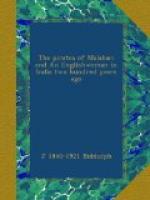In September, 1685, the Phoenix, a British man-of-war that had been sent for a two-years’ cruise in Indian waters, was attacked by a Sanganian vessel that mistook her for a merchantman. It was almost a calm, and Captain Tyrrell hoisted out his boats to capture the Sanganian ship, but they were beaten off, so he sunk her with a couple of broadsides. Forty-one of the pirates were picked up, but many of them refused quarter, and one hundred and seven were killed or drowned. The Phoenix had three men killed, one wounded, and two drowned. According to Hamilton, Sir George Byng, the first lieutenant, was dangerously wounded; but the log of the Phoenix is silent on that point, though it gives the names of the casualties.
Three years later, the Thomas, Captain Lavender, was less fortunate. Attacked by four Beyt ships, after a brave resistance, the Thomas took fire, and all on board perished.
Their depredations were not confined to the sea. In 1697 some Beyt pirates landed and plundered a village within sight of Broach.
But the losses occasioned by native pirates were at first nearly lost sight of in the more serious losses occasioned by European corsairs.
“As for those Sanganians and those Mallabars and professed pirates,” wrote the Directors in 1699, “we see no cause why you should not wage an offensive as well as a defensive war against them when they fall in your way: but it is hardly worth the while to keep small vessels to look after them, for they are poor rogues and nothing to be got of them to answer any charge.”
In 1707, the year of Aurungzeeb’s death, the pirates of the Persian Gulf made a great haul of plunder. A squadron of them made their way to the Red Sea, waylaid the Mocha fleet, and returned home laden with booty. In the following year, a squadron of fourteen Arab ships from the Gulf, carrying from thirty to fifty guns, and with seven thousand men on board, appeared on the Malabar coast and surprised Honore, Mangalore, and Balasore(?); but the people, having lately been plundered by the Seedee, were ready with their arms, and beat them off with the loss of four or five hundred men.
“The Arab insolencies are often in the thoughts of the Court,” wrote the London directors, “but the Court fears they shall not be able to do anything effectually to check their growing strength during the present war, which finds employment for all our naval force. Further, the Court sympathizes with Madras on their severe losses by the pirates, which puts a damp on the Company’s trade, and affects their revenues.”
Annoying as were the losses that were suffered from the chronic depredations of the Arabs and Sanganians, they sank into insignificance when compared with the troubles experienced on the rise to power of Conajee (Kanhojee) Angria. The growth of the Mahratta power under Sivajee had been accompanied by the formation




